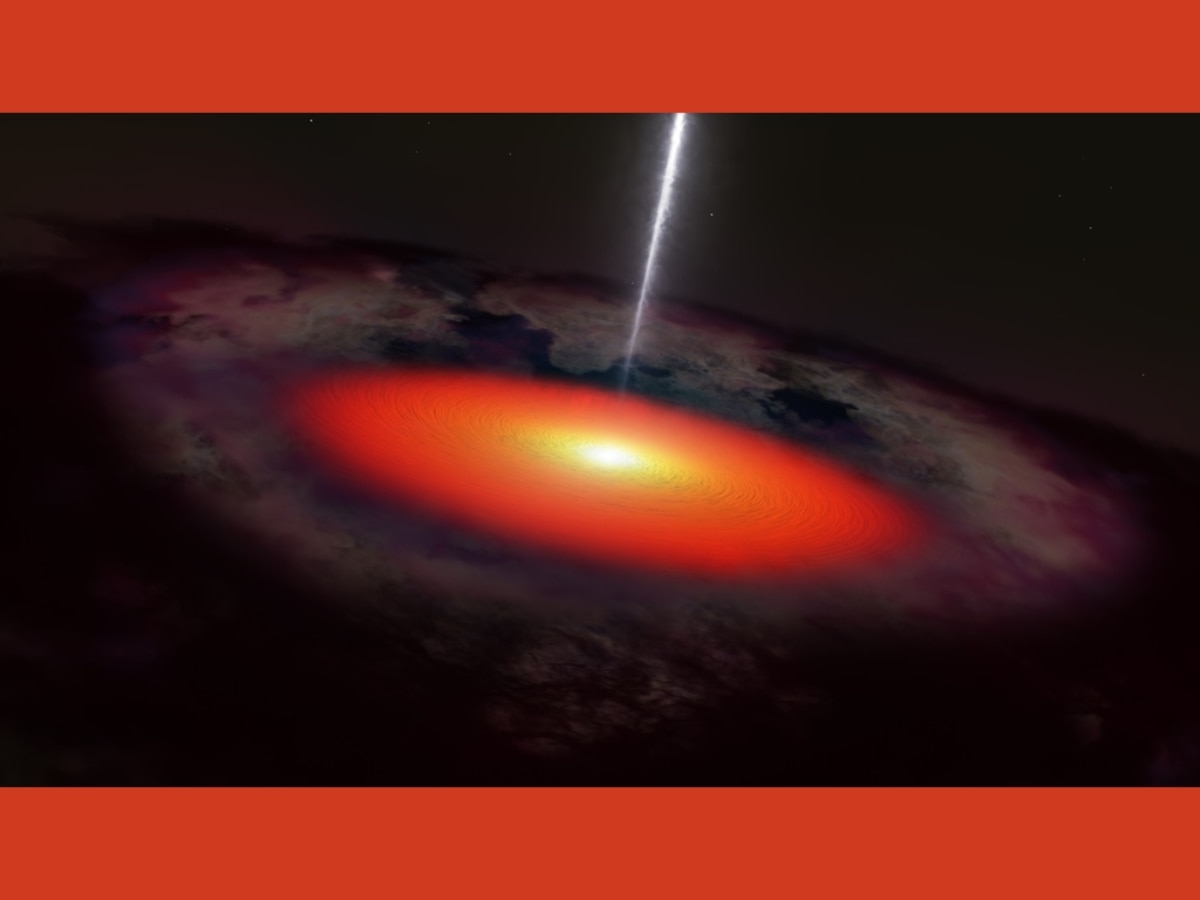Science For Everyone: What Are Black Holes? How The Colossal Behemoths Behave, And Why
Black holes are not really holes, but huge concentrations of matter packed into very tiny regions. They are so dense that their strong gravitational pull does not allow anything to escape.

Black Holes: Welcome back to "Science For Everyone", ABP Live's weekly science column. Last week, we discussed why it is said "we are all made of stardust". This week, we will discuss black holes, one of the most interesting topics in astronomy, and something which fascinates everyone because of their mysterious nature.
Over the years, scientists have been studying black holes, but not much is known about them. The supermassive black hole at the centre of our Milky Way galaxy, is called Sagittarius A*. Last year, astronomers revealed the first image of Sagittarius A*. The black hole is four million times the Sun's mass.
In 2019, the first black hole image was obtained. The supermassive black hole at the centre of the M87 galaxy is the first black hole to be captured. Recently, the image got a makeover with the help of machine learning, and as a result, the central region of the black hole appears larger and darker. The new image is called the "skinny donut".
ALSO READ | First Black Hole Image Gets Makeover, Sharper Version Appears Like A 'Skinny Donut'
Scientists have also discovered the two closest black holes to Earth. Both the black holes are of a new kind, and are located in the Milky Way. The European Space Agency's (ESA's) Gaia mission helped discover this new family of black holes by tracking the orbits of some stars. The black holes are called Gaia BH1 and Gaia BH2.
ALSO READ | Two Black Holes Closest To Earth Discovered In Milky Way, Both Of A New Kind
Black holes: Know more about these colossal behemoths
Black holes are not really holes, but huge concentrations of matter packed into very tiny regions.
A black hole is a region in space-time which has such a strong gravitational pull that even light can’t escape it, and it engulfs all matter entering it.
Black holes are so dense that their strong gravitational pull does not allow anything, not even light, to escape.
The colossal behemoths engulf everything that comes within their vicinity. The accreting matter forms a disk around a black hole, and reflects radiation, making the structure visible.
The boundary of a black hole, that contains all the matter making up the colossal behemoth, is called the event horizon. It is not a surface like that of Earth or the Sun.
Black holes: Interesting facts
The 2020 Nobel Prize in Physics was awarded to three scientists for their work on black holes. Roger Penrose won one half of the Prize for the discovery that black hole formation is a robust prediction of Einstein’s General Theory of Relativity, while Reinhard Genzel and Andrea Ghez won the other half for the discovery of a supermassive compact object at the centre of the Milky Way.
- Gaia BH1 is the closest black hole to Earth, and is located 1,560 light-years away from us in the direction of the constellation Ophiuchus. Gaia BH2 is the second-closest black hole to Earth and is located 3,800 light-years from us in the constellation Centaurus. On March 30, 2023, astronomers published a paper in the journal Monthly Notices of the Royal Astronomical Society describing Gaia BH2. They had separately described Gaia BH1 in the same journal in November 2022. Both objects were discovered last year, before being described as black holes in the respective papers.
- The most distant black hole ever detected is located 13 billion light-years away from Earth, and is present at the centre of a galaxy called QSO J0313-1806, according to NASA.
- TON 618 is the most massive black hole ever observed, and is about 66 billion times the mass of the Sun.
- The smallest black is paired up with a star, is the lightest ever found, and is about 3.8 times the mass of the Sun.
- When matter gets too close to a black hole, it is squeezed horizontally and stretched vertically, resembling a noodle. This phenomenon is called spaghettification.
On October 8, 2019, astronomers spotted the nearest example to date of a star that was shredded or "spaghettified" after approaching too close to a massive black hole. A Sun-like star was tidally disrupted, or had its material blown away after being torn apart by a black hole which is one million times more massive than the star.
The spaghettification took place 215 million light-years from Earth. Before this, the closest tidal disruption to be discovered in the recent past took place in the centre of a galaxy about 290 million light-years away from Earth.
Astronomers from the University of California, Berkeley, were able to study the optical light from the stellar death that occurred on October 8, 2019, because this was the first such event bright enough to make it possible to analyse the light.
The astronomers' observations suggest that a lot of the star's material was blown away at high speeds, up to 10,000 kilometres per second. The star's material formed a spherical cloud of gas that blocked most of the high-energy emissions produced as the black hole grabbed the remainder of the star.
ALSO READ | What Happens When A Black Hole 'Spaghettifies' A Star? First-Of-Its-Kind Study Gives Answers
The astronomers said that the cloud of gas was probably spherically symmetric.
- All black holes spin, the fastest-known clocking in at 1,000 rotations per second. The fastest-known black hole is named GRS 1915+105, according to NASA.
- Black holes are particle accelerators, and can launch particles to near the speed of light.
- If a black hole of the Sun's mass replaces Earth's star, the solar system will get a lot colder, but the planets will remain in their orbits, because the black hole will have the same gravitational pull as that of the Sun.
- Black holes can be the product of "star booms". This means that some black holes are born when massive stars run out of fuel and explode in supernovae.
- Black holes are not so rare. Most galaxies the size of the Milky Way have monster black holes at their centres.
Black holes: How they are found
Since black holes do not emit or reflect light, they are effectively invisible to telescopes. Black holes can be detected and studied based on how they affect their surroundings.
The ring of gas and dust surrounding a black hole is called an accretion disk. The ring emits light across many wavelengths, including X-rays.
The intense gravity of a supermassive black hole can cause stars to orbit around it in a particular way.

The above illustration is that of a supermassive black hole at the centre of a type of galaxy called a blazar. The image shows a bright accretion disk and a darker ring of gas and dust surrounding the black hole. The black hole is ejecting a bright jet of particles.
Black holes are extremely massive objects accelerating through space, and hence, create ripples in the fabric of space-time. These ripples are called gravitational waves, and can be detected through the ripples' effect on detectors.
Objects as massive as black holes can bend and distort light from more distant objects, in a phenomenon known as gravitational lensing. This technique helps scientists find isolated black holes that are otherwise invisible.
Black holes can also be detected by observing stars that wobble in the sky because of being gravitationally influenced by the colossal behemoths.
Black holes: Structures they should not be mistaken for
Black holes are neither wormholes nor cosmic vacuum cleaners.
The colossal behemoths are not wormholes because they do not provide shortcuts between different points in space, or portals to other dimensions and universes.
The reason why black holes are not cosmic vacuum cleaners is that they do not suck in matter located far enough away.
Black holes: Understanding the anatomy of these massive structures
The makeup of all black holes, from stellar-mass black holes with a few times the Sun's mass to supermassive black holes which weigh up to billions more. Black holes possess only three properties: mass, spin and electrical charge.
The different parts of a black hole are corona, accretion disk, event horizon, event horizon shadow, singularity, doppler beaming, photon square, and particle jets, according to NASA.

Corona
A turbulent, billion-degree cloud extending above and below the disk surrounding a black hole is called the corona. The strong magnetic fields of black holes, which are one of the most extreme physical environments in the universe, create this turbulent cloud.
![Black hole corona: This illustration shows the corona of a supermassive black hole. The corona appears like a pale, conical swirl above the accretion disk. [Photo: NASA/Aurore Simonnet (Sonoma State University)]](https://feeds.abplive.com/onecms/images/uploaded-images/2023/05/06/5506aded509fc0a8f7f328b0ccf019611683383236190324_original.jpg)
The corona of a black hole is a source of X-rays with much higher energies than those emanating from the accretion disk, and accelerate particles to velocities close to the speed of light. However, scientists have not yet been able to figure out the exact extent and shape of a black hole's corona.
Accretion disk
The hot disk of gas orbiting a black hole, and the main source of light for the massive cosmic object, is called the accretion disk. Accretion is the phenomenon of black holes consuming matter to grow.
Black holes also grow by merging with other black holes. A stellar-mass black hole paired with a star grows by pulling gas and mass from the star, and a supermassive black hole grows by pulling gas and mass from a star that enters its vicinity.
The accreted gas settles into a hot, bright, rapidly spinning disk, according to NASA. Gradually, matter moves from the outer part of the accretion disk to its inner edge, and falls into the event horizon.
Once a black hole has consumed all the matter surrounding it, the massive structure becomes isolated because it no longer possesses an accretion disk, and becomes very difficult to find and study.
According to NASA, an accretion disk has a "funny shape" when viewed from most angles because the gravitational field of a black hole warps space-time, the fabric of the universe, causing light from the disk to follow the distorted path. Therefore, due to gravitational lensing, the light coming to Earth from the top of the accretion disk behind the black hole appears to form into a hump above the colossal behemoth.
Another hump is seen below a black hole because light from beneath the far side of the accretion disk takes a different path. When an accretion disk is exactly face on with respect to Earth, we see no humps because the disk directly faces the planet, and there is no gravitational lensing.
However, when the accretion disk is viewed from different angles, it appears distorted and forms "funny shapes" due to gravitational lensing.
Event horizon
The boundary of a black hole where the velocity needed to escape the structure must be more than the speed of light is called the event horizon.
Even light cannot escape the event horizon. Therefore, the event horizon is the reason why a black hole is black.
Anything that passes into the event horizon is doomed to stay inside it, even light. An outside observer will never know what is happening inside a black hole. Since the accretion disk does not enter the event horizon, it reflects light, making it possible for astronomers to study black holes.
Event horizon shadow
The event horizon shadow is a zone roughly twice as big as the event horizon of a black hole. The combined effect of the event horizon capturing light falling into it, and refraction of light coming from the accretion disk due to the gravitational lensing effect created by a black hole, forms the event horizon shadow.
Singularity
The theoretical point at the very centre of a black hole where matter is crushed to infinite density, as predicted by the general theory of relativity, is called singularity. The final destination of anything talking into the event horizon of a black hole is the singularity.
Astronomers currently do not know whether the singularity is a physical structure or a purely mathematical one.
Doppler beaming
An effect causing the accretion disk to brighten in the regions where it spins towards Earth, and to dim where it spins away is called doppler beaming. The accretion disk spins so fast near the black hole that an effect of the general theory of relativity becomes apparent.
The part of the accretion disk spinning towards Earth reflects light which becomes brighter and bluer, while the other side of the disk which is rotating away from us reflects light which becomes dinner and redder.
This can be compared with an everyday acoustic phenomenon such as a siren, where the pitch and volume of sound rise and fall as the source approaches and passes by someone, respectively. Therefore, doppler beaming is the optical equivalent of such acoustic phenomena.
Photon sphere
The thin rings of light appearing at the edge of the event horizon shadow constitute the photon sphere. These thin rings of light appear from every viewing angle, and are multiple, highly distorted images of the accretion disk.
When light from the accretion disk reaches the photon sphere, it orbits the black hole multiple times before escaping to observers on Earth. As the rings move closer to the black hole, they become thinner and fainter.
Particle jets
![Black Hole Particle Jets: The illustration shows a thick accretion disk that has formed around a black hole after a star that wandered too close to the colossal behemoth was destroyed. Debris from the stars fell into the black hole and formed a thick chaotic disk of hot gas. Matter which came near the accretion disk was redirected in the opposite direction, resulting in a thin jet of high-speed particles. The particle jet is seen erupting above the black hole. [Photo: NASA/Swift Observatory/Aurore Simmonnet (Sonoma State University)]](https://feeds.abplive.com/onecms/images/uploaded-images/2023/05/06/e047a5dc6f8d7b37ad29f2514560091e1683383534249324_original.jpg)
Streams of matter moving away from a black hole at nearly the speed of light are called particle jets, according to NASA. The particle jets from a black hole are enhanced by the doppler beaming effect.
Near the inner edge of the accretion disk in a black hole of any size, a small amount of material heading toward the black hole may suddenly become rerouted into a pair of jets that blast away from the massive structure in opposite directions.
Astronomers are yet to understand particle jets completely.
Particle jets from supermassive black holes can reach lengths of hundreds of thousands of light-years.
Sometimes, particle jets may align with our line of sight. This helps astronomers easily detect the near jet, or the one firing towards Earth, due to Doppler beaming. Meanwhile, the rear jet, or the one away from us, becomes dim due to Doppler beaming.
Related Video
Southern Rising Summit 2024: How Important is Self-Awareness? Insights from Anu Aacharya | ABP LIVE






































